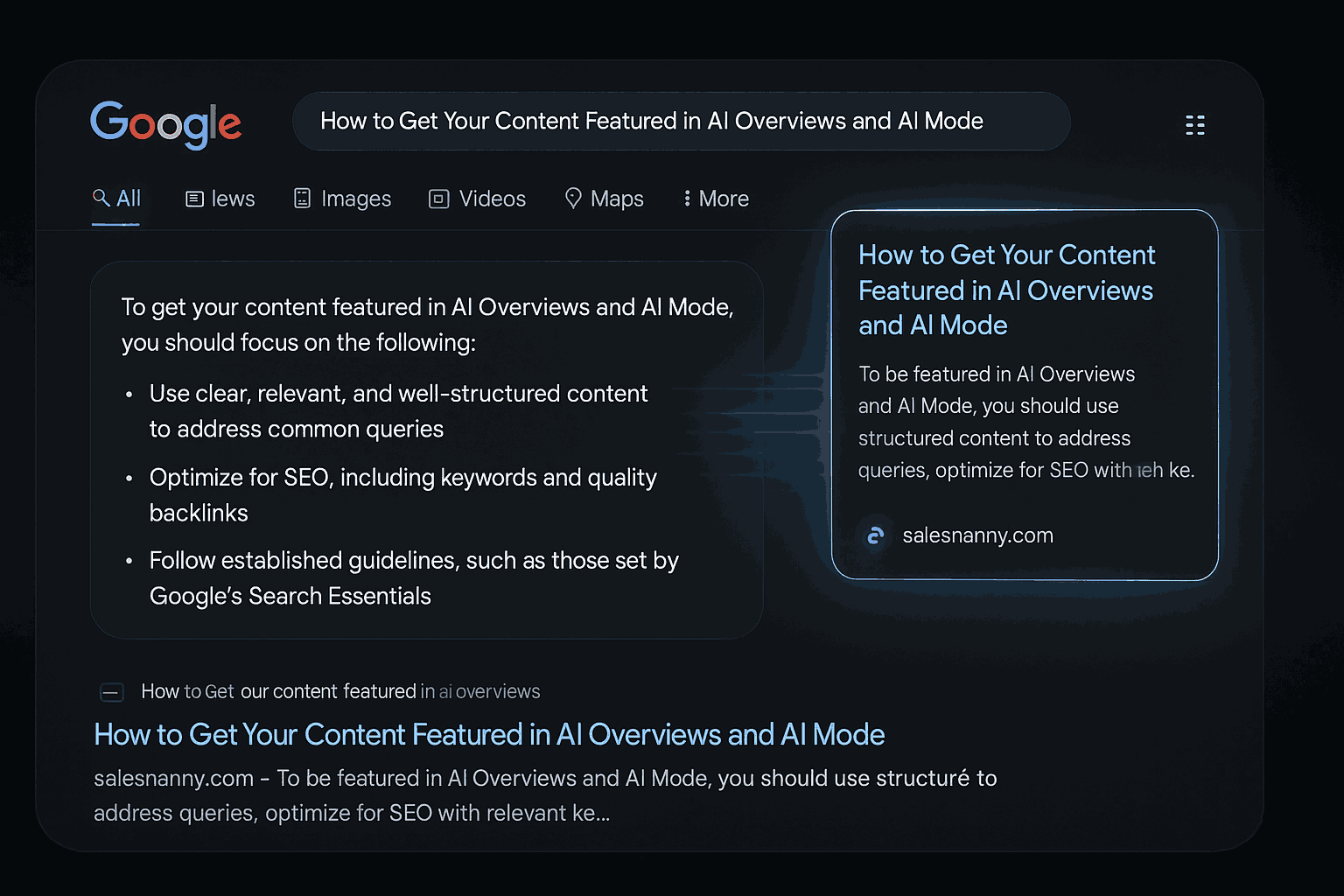Introduction
Search is evolving fast — and Google’s AI Overviews (formerly SGE or Search Generative Experience) are changing how users discover content.
Instead of clicking on blue links, users now see summarized answers powered by AI. So the big question is:
How do you get your content featured inside these AI-driven summaries?
In this blog, we’ll break down the exact strategies you need to get visibility in AI Overviews and AI Mode, based on what Google is surfacing in 2025.
What Are AI Overviews and AI Mode?
AI Overviews are auto-generated answers that appear at the top of Google search results. They’re designed to quickly answer questions using trusted sources and web content.
AI Mode is the interactive follow-up experience, where users refine queries and dive deeper into results, often without clicking a link.
Together, they represent Zero-Click 2.0 — and if your content isn’t optimized, it may never be seen.
Why It Matters for SEO
- Your organic rankings won’t matter if users don’t scroll past the AI Overview.
- Brand mentions, quotes, and structured answers are now visibility signals.
- If your site is cited in an AI answer, you build trust — and can still earn the click.
How to Get Featured in AI Overviews
Here’s a step-by-step strategy used by leading publishers and SEO experts:
1. Answer Questions Directly (AEO Principle)
Google pulls clear, structured content into its AI summaries. Use:
- H2s or H3s in question format
- Short, concise answers immediately after
- Bullet points for clarity
- Tables or step-by-step breakdowns
Example:
What is AI Overview in Google Search?
AI Overview is a generative search result that summarizes answers using AI, pulling content from trusted websites, forums, and structured data.
This mirrors how Google selects content for “featured snippets.”
2. Use Schema Markup
Structured data helps Google understand your page. Use:
| Schema Type | Use Case |
| FAQPage | Answers-based blogs |
| HowTo | Tutorials and step-by-steps |
| Product | Reviews and comparisons |
| BlogPosting | Informational content |
Tools like Schema.org or plugins like RankMath help implement this.
3. Build Topical Authority (Not Just Keywords)
Google’s AI Overviews prefer content from sites with depth, not one-off articles.
- Create content clusters on a niche topic
- Interlink them naturally
- Build a strong internal structure
- Cover definitions, comparisons, use cases, guides
Here’s a good starting point to structure your content with clusters.
4. Show Firsthand Expertise
Google’s AI is tuned to pick real experiences and original perspectives.
- Add quotes from your team or customers
- Include screenshots, videos, charts
- Use personal or brand storytelling
5. Use Author Names and Profile Pages
E-E-A-T still matters (Experience, Expertise, Authority, Trust).
Add an author bio with links to:
- LinkedIn
- Thought leadership content
- Press mentions
These elements signal trust to Google’s AI.
6. Ensure Fast, Crawlable Site Structure
- Fast-loading mobile-first pages
- Clean semantic HTML
- No interstitials blocking content
- Use descriptive headings (<h1> to <h3>)
If your site struggles here, it’s time to optimize for Google AI results.
FAQs
Q1. What is Google’s AI Overview?
It’s a generative summary box at the top of Google search results, powered by AI and showing information pulled from multiple websites.
Q2. Can I control whether my content appears in AI Overviews?
You can’t force inclusion, but optimizing for clarity, expertise, and structured content increases your chances.
Q3. Does appearing in AI Overviews replace regular SEO?
No. It complements SEO. Traditional rankings still matter — but AI placement gives an additional edge.
Q4. What content types work best for AI Overviews?
Definitions, FAQs, comparisons, guides, and expert explainers are the most commonly used content types.
Q5. How do I know if my content is being cited in AI Overviews?
You can’t always track it in Search Console yet, but you may notice traffic bumps or brand mentions from these AI citations.
Want your site to appear in Google’s most powerful search feature? Our SEO team can align your content with AI-readiness standards — structure, trust, and speed.
Final Takeaway
AI Overviews are the next frontier in search. If you’re not optimizing now, your brand may become invisible later.
Focus on clarity, authority, and topic depth — and let Google’s AI do the rest.



Leave a Comment
Surya Prakash
Hi, I’m Surya Prakash — a digital marketing strategist. I help startups and digital-first brands grow online using a mix of SEO, AEO, content marketing, and brand storytelling. You can follow my blog insights here, where I break down complex marketing topics into simple, useful ideas.
Comments
No comments yet. Be the first to comment!